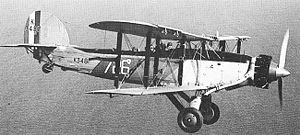avia.wikisort.org - Aeroplane
The Fairey Seal was a British carrier-borne spotter-reconnaissance aircraft, operated in the 1930s. The Seal was derived – like the Gordon – from the IIIF. To enable the Fairey Seal to be launched by catapult from warships, it could be fitted with floats.
| Seal | |
|---|---|
 | |
| Role | Spotter-reconnaissance |
| Manufacturer | Fairey Aviation |
| First flight | 1930 |
| Introduction | 1933 |
| Retired | 1943 |
| Primary users | Fleet Air Arm Royal Air Force |
| Produced | 91 |
Service life and operations
The Seal was designed and built by Fairey Aviation. It first flew in 1930 and entered squadron service with the Fleet Air Arm (FAA) in 1933. Ninety-one aircraft were produced.
The FAA started to replace it with the Swordfish Mk1 from 1936. By 1938 all FAA torpedo squadrons had been entirely re-equipped with the Swordfish. The Seal was removed from front-line service by 1938, but remained in secondary and support roles. By the outbreak of the Second World War, only four remained in service. The type was retired fully by 1943. The type was last used in India as an instructional airframe from the Royal Navy Photographic Unit.
The RAF also operated the Seal as a target tug. Twelve aircraft were part of the RAF's No 10 Bombing and Gunnery School until 1940. A further four aircraft were used by 273 Squadron in Ceylon. These aircraft were used on coastal patrols, some as floatplanes. By May 1942, the type had been retired from RAF service.
In 1934 Latvia ordered four Seal floatplanes for its naval aviation (factory numbers F.2112 – 2115, tactical numbers 26 – 29, later 98 – 101).[1] Between 22 June and 5 July 1936 three floatplanes under Colonel Janis Indans undertook a 6000 km long journey from Liepāja through Baltic and North European countries to England and back. In autumn 1940, after Latvia's annexation, the aircraft were taken by the Soviets, but they were not used by them, and they remained stored on Kisezers lake. On 28 June 1941 they were destroyed there by German planes.[1]
Variants
- Fairey IIIF Mk VI : The first prototype was converted from a Fairey IIIF MK IIIB.
- Fairey Seal : Three-seat spotter-reconnaissance aircraft for the Royal Navy.
Operators
 Argentina
Argentina
- Argentine Navy
 Chile
Chile
- Chilean Navy
- Chilean Air Force
 Latvia
Latvia
- Latvian Navy
- Latvian Air Force (from 1936)
 Peru
Peru
- Peruvian Air Force
- Peruvian Navy
 United Kingdom
United Kingdom
- Royal Air Force
- Fleet Air Arm
Specifications (Landplane)
Data from British Naval Aircraft since 1912[2]
General characteristics
- Crew: 3
- Length: 33 ft 8 in (10.26 m)
- Wingspan: 45 ft 9 in (13.94 m)
- Height: 12 ft 9 in (3.89 m)
- Wing area: 443.5 sq ft (41.20 m2)
- Gross weight: 6,000 lb (2,722 kg)
- Powerplant: 1 × Armstrong Siddeley Panther IIA 14-cylinder air-cooled radial piston engine, 525 hp (391 kW)
- Propellers: 2-bladed fixed-pitch propeller
Performance
- Maximum speed: 138 mph (222 km/h, 120 kn)
- Endurance: 4 hours 30 minutes
- Service ceiling: 17,000 ft (5,200 m)
- Time to altitude: 5,000 ft (1,524 m) in 5 minutes 20 seconds
Armament
- Guns: 1 fixed forward-firing .303 in (7.7 mm) Vickers machine gun and .303 in (7.7 mm) Lewis Gun in rear cockpit
- Bombs: 500 lb (230 kg) or stores carried under lower wings
See also
Related development
- Fairey Gordon
- Fairey IIIF
Aircraft of comparable role, configuration, and era
References
- Indans' Great Amok, "Insignia" Issue 11, Volume 3, Number 3, Spring 1999, ISSN 1360-4848, p.76-81
- Thetford 1978, p. 131.
Bibliography
- Lezon, Ricardo Martin & Stitt, Robert M. (January–February 2004). "Eyes of the Fleet: Seaplanes in Argentine Navy Service, Part 2". Air Enthusiast (109): 46–59. ISSN 0143-5450.
- Sturtivant, R; Burrow, M (1995). Fleet Air Arm Aircraft 1939 to 1945. Tonbridge, Kent, UK: Air Britain (Historians) Ltd. ISBN 0-85130-232-7.
- Taylor, H.A. (1974). Fairey Aircraft since 1915. London: Putnam. ISBN 0-370-00065-X.
- Thetford, Owen (1978). British Naval Aircraft Since 1912. London: Putnam. ISBN 0-370-30021-1.
- Vicary, Adrian (1984). Naval Wings. Wellingborough, UK: Patrick Stephens Ltd. ISBN 0-85059-660-2.
External links
- Fleet Air Arm Archive
- Fairey Seal – British Aircraft of World War II
- Latvian Aviation
На других языках
[de] Fairey Seal
Die Fairey Seal war ein trägergestütztes, als Doppeldecker gestaltetes Aufklärungsflugzeug und der Fairey Gordon sehr ähnlich. Beide waren Weiterentwicklungen der Fairey IIIF. Die Fairey Seal wurde in fünf Aufklärungsstaffeln von 1934 bis 1936 eingesetzt, allerdings übernahmen zwei Staffeln ihre Seals von bereits wieder umgerüsteten Staffeln. Einige Maschinen wurden zwischen 1932 und 1938 auch als Bordflugzeuge eingesetzt und bis 1940 wurden Seals in Ausbildungseinheiten verwendet.Die letzten verbliebenen Maschinen wurden als Zielschleppflugzeuge genutzt.- [en] Fairey Seal
[ru] Fairey Seal
Фэйри Сил (англ. Fairey Seal — морской котик) — британский палубный торпедоносец.Другой контент может иметь иную лицензию. Перед использованием материалов сайта WikiSort.org внимательно изучите правила лицензирования конкретных элементов наполнения сайта.
WikiSort.org - проект по пересортировке и дополнению контента Википедии